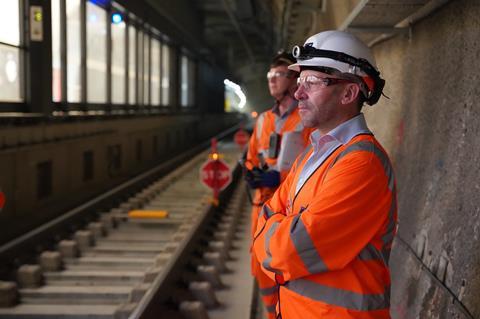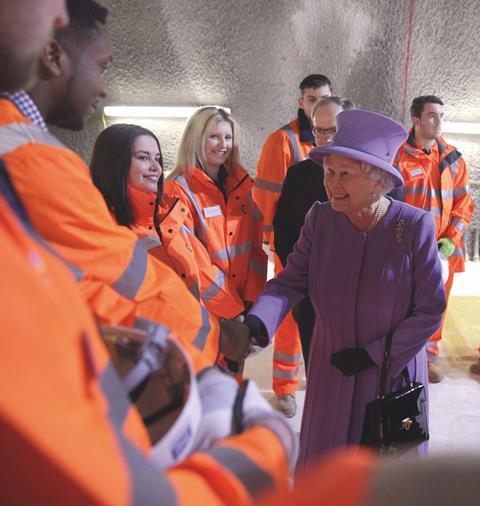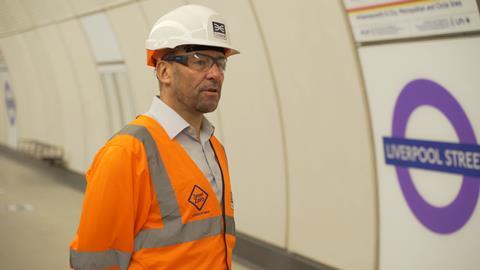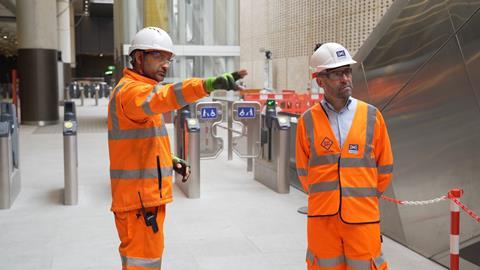There are just two questions people want answered about Crossrail: when will it open and how much is it all going to cost? Well, says project boss Mark Wild, that all rather depends…

Thirty-seven days. That is how much time there was before Crossrail’s original opening date when Mark Wild joined the project.
It was 2 November 2018, to be precise – 63 days after his predecessor Simon Wright had confirmed that the scheme, long-lauded as the gold standard for delivering major infrastructure on time and budget, would not be ready on time on 9 December.
This date had been in the diary for almost a decade, with the Queen lined up and ready to open the route that will finally bear her name on its completion.
At the time the project had just been given an additional £350m, bringing its then total cost to just over £15bn. Everyone’s greatest fear had been that it would be 12 months late. But, just five weeks after taking over, Wild revealed that the project would require another £2bn – and that he could not even confirm an opening date.
Fast forward to today and the scheme is close to 1,000 days late – an inauspicious milestone that will be passed this summer. The central London section of the east-west route is now expected to open some time in the first half of 2022. Trial running, the first operations-like testing phase of trains in the project’s 42km of new tunnels, has just begun and there are questions about whether the scheme can be delivered within the current overall budget of £18.6bn.
Despite all this there is no denying that Crossrail has come a long way since Wild took the helm. Speaking to him, it is hard not to feel cautiously optimistic that there might finally be light at the end of the tunnel.

“I guess the project’s made a lot of progress. We’re in this phase of trial running and the next phase is trial operations, with the plan for that transition to be made some time later in the autumn,” Wild says. “So I think broadly that the project has made a big, big step forward, but I guess it’s all about where we get to in the future and we still think the first half of 2022 opening window is valid.”
Wild’s enthusiasm for the work and the project is undeniable. The 56-year-old does not shy away from the hard realities of the scheme, saying that he is “acutely aware” of the disappointment felt by the public and project’s sponsors, the Department for Transport (DfT) and Transport for London (TfL), that it is not already open.
Wild is an obvious expert in the field – readily slipping into industry speak when discussing the project. But what is perhaps more rare is that he was equally happy to explain these complexities – a must given the high-profile nature of the project.
He does not understate the problems that have plagued certain parts of the scheme, such as those at Bond Street station, or more recently the complexity of the assurance work. But he also sees the benefits that the scheme will bring; the impressive nature of the feats of engineering and the legacy and lessons learnt that can be applied to other big infrastructure projects in the UK, be they HS2, Crossrail 2 or Northern Powerhouse Rail.
Fixing things
An electronic and electrical engineer by trade, Wild has been responsible for public transport systems and projects around the world. He headed up Public Transport Victoria in Australia, was managing director of the London Underground and held the same title at Invensys Rail Group before it was sold to Siemens. But there is no denying that Crossrail has been his greatest challenge yet.
“The Elizabeth line is so crucially important to the Underground, to TfL, to London, I guess you want to be there to fix things, don’t you?” Wild says. “The project obviously got into difficulty in 2018 but it’s a great, great project, one of the world’s great transportation projects. So to get that opportunity is not one to be turned down really and it’s also a great challenge.”
The position Wild found himself in was not unique – parachuted into a failing project or company to bail it out – but was nonetheless tough. And much tougher than he realised at the outset. “I would say the gap was surprising. And, even when I took this job on, we didn’t fully calibrate the extent of the gap,” he says.
“I can’t really comment why the gap existed. Yes it was surprising, but you can only deal with what you’ve got in front of you.”
There is still plenty more in front of him. Wild says he remains confident that, 12 months from now, we will be looking at an open and operating central section of the railway, that he and his team will be looking to integrate the east and west branches – and that the project will be what it was once heralded as, a feat of engineering.
“The project obviously got into difficulty in 2018 but it’s a great, great project, one of the world’s great transportation projects”
Mark Wild
“When it opens, I think people will be impressed by and notice the scale of it, as well as being impressed by the great outcome that will be the connectivity it offers.” It will take 40 minutes to get from Canary Wharf to Heathrow, or just over 20 minutes from Abbey Wood to Paddington.
That being said, he does not shirk away from the position the project currently finds itself in. “We know how serious the overrun has been. It is serious. It has cost time and money,” Wild says.
“People have bought apartments, vendors and traders have been disturbed by it. So, yes, we take it really seriously. We just have got to get this off.”
Apart from opening date, there is one other obvious question: how much is it all going to cost? Wild says it is too early to say what the grand total will be.
Asked if the £825m handed to the project by the government late last year will be enough to deliver it, or whether he will need the full £1.1bn he went cap-in-hand to the DfT for, Wild says he cannot guarantee it – but that the key will be opening the project as soon as possible.
>> Crossrail: How the delay has unfolded
>> Crossrail will open with or without Bond Street, £18.6bn scheme’s boss says
>> Crossrail boss sounds alarm over industry shortage of engineers
“We calculated the £1.1bn last year and it’s still valid now, as is the opening window,” he says. “But clearly, as we push hard to get as early in that window as we can, that will have a consequential saving in the £825m. Whether we can get within it or slightly over it, you’ve really got to let trial running happen.”
A clearer picture on how trial running is going, and the cost and budget ramifications of that, will not emerge until later this summer or early in the autumn, Wild says.
Trial running has been a goal for years, and long considered the key milestone as it signals the switch from full-blown construction site to operational railway. Trial running began on 10 May and the railway is currently running a timetable of four trains an hour through the central London tunnels. “It’s going pretty well, actually,” Wild adds.
The next key will be stepping up to eight trains an hour in the next couple of weeks and then, after that, to 12 trains. “We are in the famous phase of trial running, which is of course all about reliability, shaking out the bugs.”
The ramifications if it does not go well will be significant from both a time and cash perspective, but Wild is quietly confident that the work done to this point should lead to, if not quite smooth sailing, at least the avoidance of shipwrecks.
Problem stations

The uncertainty of this testing, and the subsequent trial operations phase, is not the only risk to the scheme, with work at three key stations providing more choppy waters. The huge amount of assurance work required, work to prove the railway has been completed to the appropriate standard and is safe, is taking significantly longer than anticipated.
Canary Wharf, Whitechapel and Bond Street are the problem stations, and each has its own issues. Problems at the first two include systems integration delays and the simple fact that you cannot commission 10 new stations at once. Despite this, Wild says there is no doubt that Canary Wharf and Whitechapel will open with the rest of the route.
“I’m confident the rest of the stations, including Canary Wharf and Whitechapel, they’ll get there, but we couldn’t delay the whole railway just because of Bond Street”
Mark Wild
Bond Street is another story. The station must hit SC2, which means it can be used as an evacuation point, or it will delay the route. But Wild says it will not reach that stage until early autumn. Whether it hits SC3 – the point at which it could be commissioned into use – in time for it to open with the rest of the route will largely depend on how early into next year the rest of the line is ready to go, he says. At the moment Bond Street looks likely to hit this milestone early-mid next year. In other words, they will not wait for Bond Street.
“I’m confident the rest of the stations, including Canary Wharf and Whitechapel, they’ll get there […] but we couldn’t delay the whole railway just because of Bond Street,” Wild says. “So it depends on when the railway opens. If the railway opens around the time that Bond Street is available, then it will be in it. And we are going to do our very, very best to really bring forward that SC3 date as much as we can.”
The trouble at Bond Street also dates back to the tunnelling. There were design co-ordination challenges in the early years of the project. Despite the Costain-Skanska team (CSJV) that was building Bond Street leaving the job last year, Wild says he cannot lay the blame for the delays squarely at their feet. “We’ve turned a big corner on Bond Street really in recent years even with CSJV in charge of the project, we’d really turned the corner,” he says. “They’ve been carrying this lateness, one year to 18 months, [since] the very beginning of the job, so I feel a bit sorry for them for that,” Wild says.
The assurance challenge
The assurance work on the scheme was always going to be a headache, with hundreds of assets that need to be checked and signed off. “Working on a safety-critical digital railway, particularly working in London in a sub-surface environment, assurance was always going to be one of the most challenging things,” he says.
“I think London and the UK are among the more challenging [areas] in the world of working in this area.”

While acknowledging that a number of Office for Rail and Road (the non-ministerial government department responsible for the economic and safety regulation of Britain’s railways) submission dates had not been hit, Wild says the biggest hurdle in this sort of project was establishing the safety case that enabled the project to move into trial running. It is something that has now been ticked off but, Wild says, it is obvious there is still a lot of work to do in this area, with the sheer volume of assurance work still considered a project risk.
“The really big hurdle to get across in assurance is to establish the safety case of the end-to-end railway. That was a really huge effort to get to that point,” Wild says. “Once you’re there, you’re on kind of a plateau of assurance and going forward, it will, of course, remain to be very, very challenging and difficult but broadly, I think the joint teams now have a really clear understanding of what they need to do.”
If all that was not trouble enough, the project, like the world at large, has had a difficult past year with covid-19 throwing another curveball into the mix. Crossrail’s sites were brought to a standstill for almost four months and, while Wild feels a series of construction blockades, a period when construction work is prioritised over testing, have helped the project catch up from a time perspective, he concedes the pandemic and efforts made to prevent it further delaying the scheme have undoubtedly had a cost impact.
“You can’t say the pandemic was good news for us but I think we’ve done our very best to recover from it,” Wild says. “It undoubtedly cost a bit more money, but in terms of time, we did our best to recover in the blockades. It [the extent of the cost impact] won’t really be qualified until you get to the end, and you look back because in a strange way, we haven’t really washed through the effect of the blockades.”
Lessons learnt
It is imperative, Wild says, that lessons learnt are taken from this project and applied elsewhere. In fact this process is already under way and the Crossrail team has been working with those behind both HS2 and the currently-in-limbo Crossrail 2 to make sure this happened.
On that point, Wild is a fervent believer in the merits of the scheme’s successor. “Crossrail 2 is essential for London and the country really,” he says. “Cycles of transport infrastructure investment are quite long, so I’m sure Crossrail 2 will come.”

Reducing complexity and increasing systems integration must be considered from the outset in future. “At the beginning of projects, make sure that that complexity is minimised. Crossrail is one of the world’s first truly digital railways, so I guess in some ways, it was always going to be a real challenge.
“We’ve learnt a lot about modularity, plug and play, how to design things in that it will be easy to commission – so that will be important.”
One of the best things Crossrail did over the past few years, Wild says, was making the decision to take over the management of the tier two and three supply chain. “The thing that we did well was to look deeper into the supply chain at tier two and tier three, where you do actually find some relatively scarce and unique skills,” he says. “And we co-ordinated the tier two and tier three scarce resources.”
He says subcontractors such as those that carry out fire engineering, systems integration at the business management level, and system assurance were among those skills that needed to be well-managed due to the scarcity of suppliers in these specialisms.
“Whether people think I’ve done a good job doesn’t bother me that much really, because I think the team have just got to keep going and get it finished.”
Mark Wild
While outside of this resource management Wild has not found skills lacking on Crossrail – the headline-grabbing project is in a rare position to be able to attract the “best and the brightest talent” not just from the UK but from around the world – he is concerned about the future of the sector.
“We’ve got a deficit of engineers. I think the whole STEM debate and [concern about] the pipeline of engineers is a real thing. If you look a little bit further forward into the mega-projects to come, your HS2s, your Northern Powerhouse Rails, there’s probably something quite serious about the skills gap.
“I’m 56. I’ve been in this all my career. And there’s a gap underneath that. So I think that urgently needs to be replenished.”
Looking to diversify the engineering and construction industry is integral to this, he says, if future projects wish to avoid the headaches caused by a failure to be properly resourced.
Asked if he has any idea what he wants to do when Crossrail finally completes, Wild’s answer is a simple “no”. He has more than enough to be getting on with on this job without looking farther ahead.
And that no-nonsense response seems to sum up his attitude to the whole project: set up the best team you can, make decisions and don’t look back; keep pushing until it is finally done – and then the outcome will determine itself.
“I’m very proud of my team and I’m sure, when all is said and done, they will look back and say they have done a good job,” he says. “Whether people think I’ve done a good job doesn’t bother me that much really, because I think the team have just got to keep going and get it finished.”



























No comments yet